Xeroderma Pigmentosum, has been claiming lives of children in Kuratti Hosur, Bhadrenahalli and Shettalli. More are struggling to stay afloat without medical assistance.
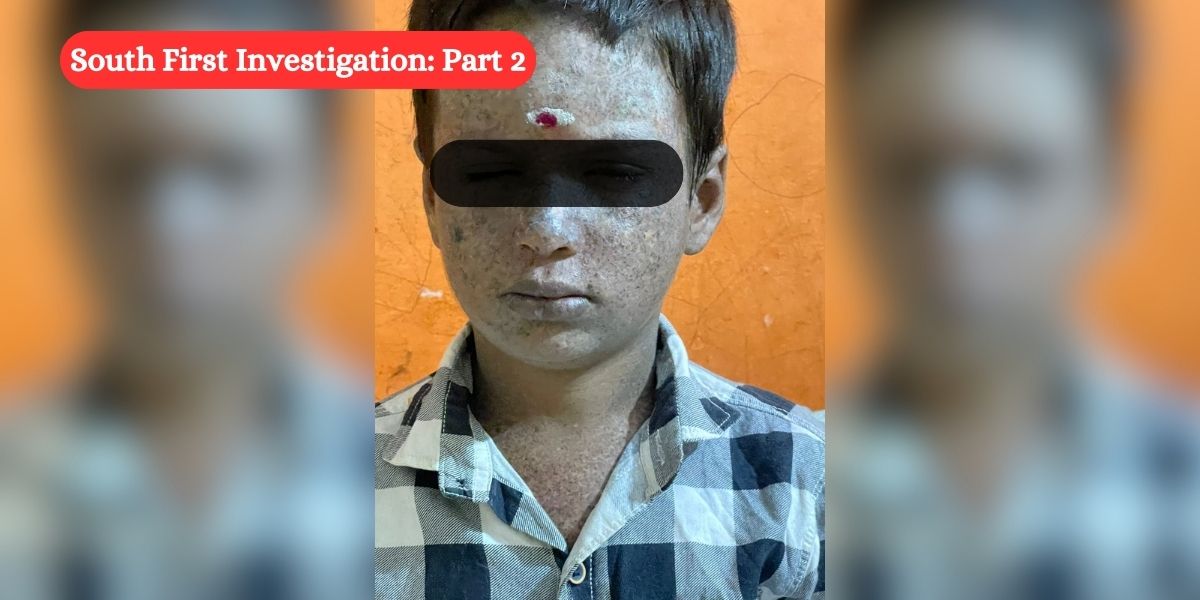
Seven year old Naveen who is currently in Bengaluru loves to read and write. (Chetana Belagere/South First)
This is the second of a three-part investigative report on Xeroderma Pigmentosum, a genetic condition characterised by extreme sun sensitivity. Several children of three villages in Karnataka’s Chamarajanagar are forced to sequester themselves indoors for an additional lease of life, which the villagers firmly believe, won’t go beyond 18 years. Their belief is based on experience, and hence they are not seeking medical assistance. The children are left to die a miserable death. Read the first part here.
Munimadashetty was a picture of stoic resignation. The light green walls of his house at Kuratti Hosuru presented an eerie feeling of fading hope and optimism.
The sun was getting hotter when South First caught up with the retired teacher, 75. His gaze was sharp like memories he has of his daughter and two grandchildren, who had fallen victim to the dreaded “chukki kayle” (the disease of dots), as the villagers term Xeroderma Pigmentosum (XP). It is easier to pronounce and identify.
Chukki kayle is not new to Munimadashetty. He had come across it many decades ago.
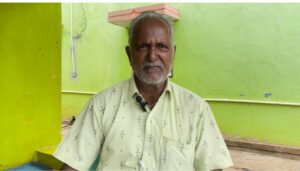
Munimadashetty, retired school teacher of Kuratti Hosuru, who lost three members of his family to the rare genetic condition. (Chetana Belagere)
“This disease was seen 70 years ago at the nearby Shettalli village. Mashetty’s two children — a boy and a girl — got this disease. In Bhadrenahalli, there was one boy,” he recalled.
“I noticed it when I visited my relative at Shettali. But no children in our village, or Bhadrenahalli, then had this condition,” the former teacher said. Unknown to Munimadashetty, neither Kuratti Hosuru nor Bhadrenahalli had any defence against chukki kayle.
The septuagenarian sat still for a moment, his eyes fixed on the opposite wall. “Around 20 years ago, a couple of children in Kuratti Hosuru caught the disease. Later, it was reported from Bhadrenahalli,” he narrated the sequence.
“Muniyamma was 16 when she died,” Munimadashetty said with a deadpan expression. A deep breath later, he continued: “Jayaraju was 10 and Jashwanth six.” He was speaking about the death of his daughter and grandsons.
He said several families reported the condition in their children in the past 20 years. He had seen the worst case of XP in his daughter. “Her eyeball popped out. I had to prick it before taking her to the hospital,” the retired teacher pursed his lips, as if in disapproval.
The silence that followed explained his constant expression of stoic resignation. Even the normal village noise outside drowned in silence as the reality sank in. It became quiet, blank and still.
A brief pause later, Munimadashetty broke the silence, hinting at a possibility.
“I have been seeing many children in our community getting this disease,” he said.
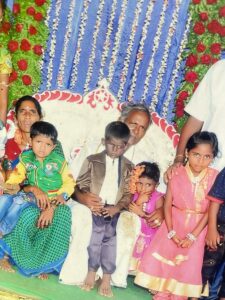
Jashwanth with his grandfather Munimadashetty . Jashwanth died due to the rare genetic condition. (Supplied)
Basavanna, the father of Savitha, 13, in Kuratti Hosuru, who is afflicted with XP, too, mentioned “the community”.
“I am baffled by the way this is spreading. Initially, it was only in Shettalli. Now, all three villages have many children with the same condition. Why is it happening only in our community,” he wondered.
Munimadashetty and Basavanna belong to the Banajiga Shetty community. Marrying within the family is common among the community members. The three villages — Shettalli, Kuratti Hosuru and Bhadrenahalli — together have around 3,500 Banajigas.
In over a decade, 10 children in these villages died of XP. Santhu, a six-year-old boy, died in Bengaluru about 15 days ago, the villagers said. There is a one-and-a-half-year-old- old girl in Bhadrenahalli, a 13-year-old girl and a seven-year-old boy in Kuratti Hosuru.
The numbers are on an uptick, yet the staff, including doctors, at the public health centres around these villages are unaware of the condition. They have no answers when desperate villagers seek their advice. ASHA worker Jayamma was one among them.
“In the past 15 years as an ASHA worker, I have seen six such children. Of them, three have died and there are three more,” she told South First.
Finding that the public health centre could not offer any help, she decided to take the children to the district hospital.
“I took two of them to the Chamarajanagar District Hospital. The doctors identified it as a rare condition and said there was no cure. I don’t have an answer to give these people,” she expressed helplessness.
“The doctors blamed the condition on marriages between blood relations within the family,” Jayamma added. “But the villagers will have nothing of it.”
Three families with children suffering from XP have shifted to Bengaluru. South First caught up with them.
Naveen is seven and has XP. His mother Puttharajamma delivered a baby girl recently and is staying with her brother at Kalidasa Layout in Bengaluru.
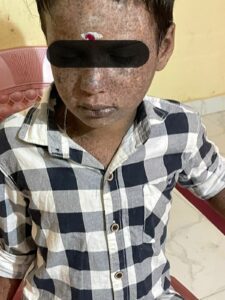
Seven year old Naveen who is currently in Bengaluru loves to read and write. (Chetana Belagere/South First)
“My son has 10 more years left,” Puttharajamma softly whispered. “I realised he too has caught the disease like some other children in our village when he was nine months old.”
Naveen’s elder and younger sisters are healthy. “We call this condition chukki kayle. We don’t know what it is called. But we know that there is no treatment. Children with this disease will die by the age of 18,” the mother lamented.
Little Naveen wants to go to school like his sisters and others of his age. It is a dream that may never materialise.
The child, however, is not willing to give up. “He reads with his sisters at home,” Puttharajamma said.
Praveen Kumar works in a Bengaluru-based private hospital. He noticed the changes in his daughter Heishika’s skin when she was around nine months old. She developed freckles and spots whenever they took her outdoors.
“We initially thought that her skin went dry since it was winter. We applied moisturisers. When the condition persisted, we took Heishika to several doctors in both the public and private sectors. We tried Ayurveda, too,” the doting father told South First.
Heishika’s parents were worried and confused. They took her to the Manipal Hospital, where dermatologist Dr Divya Bhat identified the disorder.
“The doctor identified the condition as Xeroderma Pigmentosum and told us that there is no cure,” Praveen said.
Heishika is now four. Her parents have enrolled her in a private school in Bengaluru. Except for the brownish spots, her skin appears normal.
Interestingly, one of the families that migrated to Bengaluru has a different tale: The child’s condition is improving without any treatment, the family claimed.
Shivakumar, a caterer, left Kuratti Hosuru with his family, including his son Nagaraju, who has XP.
“My son’s condition is improving here in the city. Earlier, he wouldn’t open his eyes under the sun. Now he is not bothered. The spots, too, are disappearing,” he said, adding that the boy is attending school like any other normal child.
Medical experts, however, are appalled. Though Shivakumar’s claim could not be verified, dermatologists told South First that XP, for now, is irreversible. They also warned against exposing the child to ultraviolet rays.
Unlike several other parents of XP-affected children who are resigned to fate, Heishika’s father Praveen Kumar has decided to soldier on against the odds.
On a doctor’s advice, Kumar did a genetic test to understand the type of the condition. Dr Srishti Betsurmath, a dermatologist at Kosmoderma Skin, Hair and Body Clinics, shed more light on the disease.
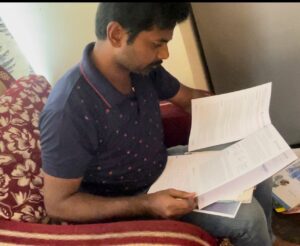
Heishika’s father Praveen Kumar, who is trying his best to protect his daughter from sunlight. (Supplied)
“This condition has different types, represented by letters A through G, plus an extra variant called XPV. About 90 percent of XP cases fall into Groups A, C, D, and XPV,” she said.
Dr Betsurmath had attended to two XP cases from Kuratti Hosuru when she was with the JSS Medical College in Mysuru.
After the gene test, Kumar now knows that his daughter is adfflicted with the C variant, which affects only the skin and vision, unlike type A which could affect the nervous system.
“I paid a private lab in Bengaluru ₹25,000 for the gene test. This test is not done everywhere,” Kumar said.
He is also spending huge amounts on moisturisers and sunscreens to protect Heishika from ultraviolet rays. “The condition can progress into cancer but I am hoping to prevent it,” Kumar is determined.
Though doctors held consanguine marriage responsible for children suffering from the genetic disorders, it is baffling that only children of the Banajiga Shetty community in these three villages are affected with XP.
Globally, only one in a million people have this condition. Children with XP exhibit severe sensitivity to sunlight by around nine months of age, especially their eyes and the skin around them develop blisters if exposed to sunlight even for five minutes.
“It is an incredibly rare genetic condition. Throughout my clinical practice, I’ve encountered only two to three cases so far,” Dr Deepa Bhat, Genetic Counsellor of JSS Medical College and Hospital in Mysuru, told South First.
“It surfaces when a person inherits two abnormal genes, one from each parent. This double inheritance means the person’s skin can’t properly repair damage caused by the ultraviolet rays,” explained Dr Bhat.
The Banajiga Shettys in the three villages of Kollagala taluk are seeking answers. Years ago, only two children had this disease, but the number is now increasing.
“This is definitely in the genes of these three villages. Counselling these people and making them aware of the dangers of marrying within the community is a must,” Dr Bhat said.
Heishika’s father Kumar knows his daughter has the C variant of XP. Savitha, Deeksha, Naveen and Nagarjun’s parents do not. Helplessness has made them watch their children’s misery in resigned silence.
“My daughter will celebrate her 14th birthday this August. It means she is a year closer to death,” Savitha’s mother Lakshmi told this correspondent while bidding goodbye.
“I hope your report will prevent more children from dying in our community,” the teary-eyed woman forced a smile.
Dr Bhat felt the issue should be dealt with immediately. “The Health Department should immediately intervene in the matter. Genetic carrier testing of families should be done or else the gene will continue and the number of children born with not just this condition but several other diseases could also increase,” she warned.
The doctor admitted that she was unaware of the gravity of the situation.
“Until you informed me, even I, as a researcher and doctor, did not know that there is a segregation of cases in these villages. No research has been done so far in these villages. It should be urgently taken up,” she said.
Kollegala taluk is not far way. It is some 150 km from Bengaluru — the seat of power that could decide whether the XP-affected in the three villages should remain children of a lesser god.
(In Part 3 of the South First investigation into Xeroderma Pigmentosum-afflicted children: Patients have been identified, hoping they get the assistance they need.)

May 20, 2024

May 20, 2024

May 20, 2024

May 20, 2024

May 20, 2024

May 20, 2024